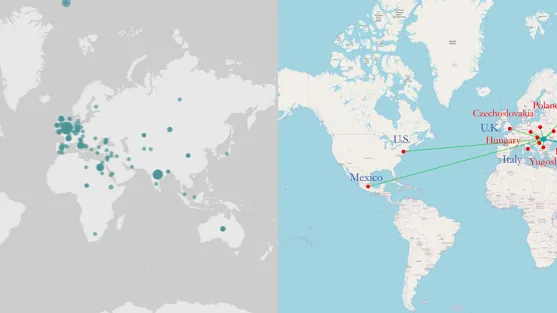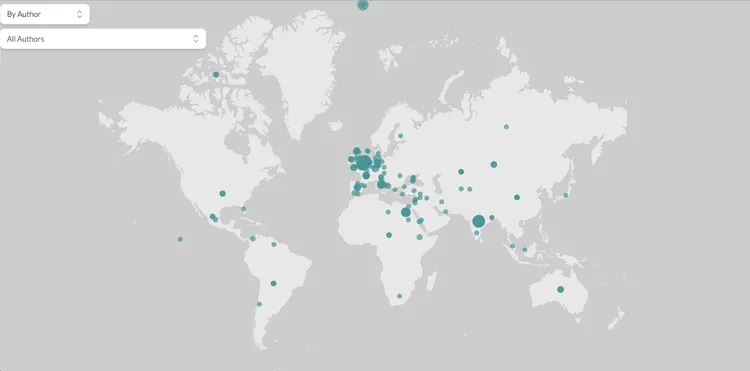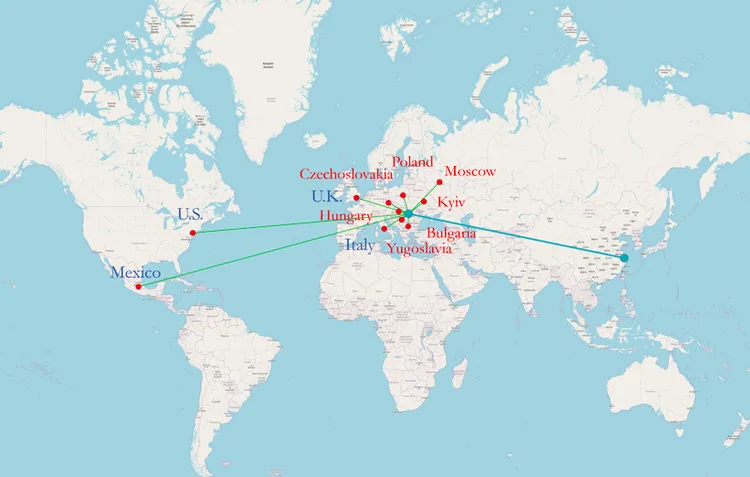Meet the Spring 2023 CDH Grad Fellows
7 June 2023
Five graduate students excel in bringing together their research questions with DH theories, methods, and tools.

In spring 2023, the Center for Digital Humanities welcomed five graduate fellows: Kate Clairmont (English), who continued her fall 2022 fellowship, Ashton Fancy (Art and Archaeology), Yang Li (History of Science), Lidia Tripiccione (Slavic Languages and Literatures), and Madelyne Xiao (Computer Science). Each of the Fellows worked on projects which fused their research interests with DH theories, methods, and tools. The Fellows encouraged each other in their research goals and worked closely with CDH staff to learn new skills.
The Fellows’ projects and goals varied, according to their research interests and backgrounds. For example, Ashton asked what architectural representations meant to ancient Roman viewers (and how these representations shaped their environment), while Madelyne focused on contemporary issues involving dis/misinformation on popular podcast shows.
Kate’s project focused on nineteenth-century British fairy tales. “My dissertation, ‘Magical Elsewheres: Setting and Place in the Nineteenth-Century Fairy Tale,’ tracks setting and place in a corpus of fairy tales and anthologies that form the basis of my research,” Kate said. “I argue that most fairy tale settings in my source material are not abstract, but rather take place in actual locations known to readers. In my DH project, I was interested in mapping and visualizing the settings of fairy tales.”
Kate held a year-long fellowship with the CDH, and so in the fall of 2022, she first curated a set of texts to situate her research. Subsequently, she used BookNLP, a natural language processing pipeline trained specifically on nineteenth-century texts.
“Using BookNLP, I worked with a corpus of 61 fairy tale texts written by well-known literary writers of the time, and then used GIS mapping tools to generate a precise map of specific locations mentioned,” she said. With the support of a CDH Seed Grant, she was able to hire an undergraduate research assistant, Ben Chan, to help her create a website, Fairy Web, which features an interactive map with the specific place names occurring in the nineteenth-century fairy tales she focused on.
During the spring 2023 semester, Kate continued her research by going through popular English nineteenth-century fairy tale anthologies and translations (like Andrew Lang’s The Blue Fairy Book, for example), and specifically mapping the locations mentioned in those anthologies.

Graduate Fellow Kate Clairmont created a website, Fairy Web, which features an interactive map with the specific place names occurring in the nineteenth-century fairy tales she focused on in her research.
“This time I used BookNLP to scan about 20-30 texts, but each ‘text’ contained 60-100 stories, so it took a long time to clean and organize the data,” she said. “But the results from these scans were even more compelling than the original database I used. They yielded an even higher volume of specific, mappable locations than the literary list I used in December, and allowed for a point of comparison with the original database.”
Yang also used visualizations in her project. “My CDH project is related to my dissertation, ‘Antibiotics, Scientific Expertise and Pharmaceutical Marketplace in the People’s Republic of China, 1949–1990,’” she said. “In my dissertation, I examine the complex interplay between science, technology, and medicine in socialist China through the lens of antibiotics. My CDH project mapped out China’s pharmaceutical technoscape using data on pharmaceutical factories collected during my fieldwork.”
Yang originally set out to use digital humanities to help her organize the sources she collected during her fieldwork. “I collected roughly two hundred volumes of pharmaceutical factory gazetteers that contain information on the construction scale, products, and annual output of pharmaceutical factories in China over decades,” she said. These gazetteers sometimes contained other information, such as human resources, raw materials, and the origins of the technologies. “It is likely the most comprehensive data collection on pharmaceutical factories in socialist China.”
The sheer amount of information she discovered was impressive, but difficult to organize. “Combined with published historical statistics and information from local gazetteers, this collection of pharmaceutical factory gazetteers can provide the basis for mapping the historical impact of China’s pharmaceutical technoscape,” she said. “But most of these documents are not OCR-ed and will be quite difficult to OCR because some are handwritten. For my CDH project, I was curious to see if there were any digital humanities tools which could help me process this collection faster, and to make beautiful maps out of this collection for my dissertation.”
She did realize that “at this stage, our current technology is still rather limited” in helping her to process the collections as she had originally intended. However, she began to look for other data on China’s pharmaceutical industry and explored ways of visualizing those data. “It turned out to be more fruitful than I initially imagined,” she said. “For example, I excavated data (from books, government documents, statistical yearbooks, etc.) and used Excel to try different ways of visualizing the data.” For instance, she tried visualizing the change of drug prices over the decades, or plotting the size of pharmaceutical industrial output in regards to geographical regions. “This experience hast taught me that data visualization is crucial, as it reveals patterns more clearly than numerical data in tables.”
Yang also succeeded in creating informative maps for her dissertation. “I registered for the GIS workshop and went to almost every session,” she said. “It was super helpful! The two teachers at the Princeton GIS workshop, Tsering Wangyal Shawa and Bill Guthe, were especially helpful. I learned all the wonderful things that we can do with a map. I made several useful maps for conference presentations to demonstrate the flow of pharmaceutical technology across the so-called ‘iron curtain’ or ‘bamboo curtain’ in the global Cold War. I received many compliments on the use of maps at those conferences.”

Graduate Fellow Yang Li explained that her map “illustrates how, through Sino-Romanian exchanges in the early 1960s, China was able to acquire a wealth of information on antibiotic technology and pharmaceutical markets across various countries and regions, both within and outside of the socialist bloc.”
Both Yang and Kate’s projects corresponded with their overall dissertation. Yang’s CDH project helped her write a chapter on the pharmaceutical industry in China. “I also plan to make a website and provide the maps and figures I made to the public,” she said.
Kate’s dissertation is informed by the digital analysis she performed. “While the chapters of my dissertation focus on specific texts or authors,” she said, “overall, I am looking at how fairy tale locations are mappable rather than abstract, and why they might be located in specific places. Visualizations and computational tools help me to make and strengthen my argument.”
Lidia’s project, however, was not related to her dissertation. She centered her CDH project around a set of questions: What are the historical conditions for foreign languages to thrive, and what role do immigration and politics play in curriculum changes? “My dissertation has nothing to do with these issues, and does not employ quantitative methods,” she said, “but I thought that the CDH fellowship would be the perfect opportunity to ask these questions in the context of Slavic languages.”
Over the course of her fellowship, Lidia “dug deep” into U.S. college enrollment data in Russian, Polish, and Czech language courses. “The work to do was a lot,” she said, “but the analysis allowed me to understand the broadest historical trends related to the study of these languages in the USA.” Lidia plans to continue the work on this project over the summer, and eventually publish an academic article on her findings.
Each of the Fellows had different paths which led them to their interests in digital humanities. For Lidia, her interest in digital humanities began “in the fall of my fourth year, when I audited a class in data analysis (SML 201) and learned how to code in R. In the summer of that year, I was a fellow at the MLA thanks to GradFUTURES, and I was tasked to analyze their database, which included enrollments in languages other than English in American higher education institutions from 1958–2016.” This previous experience helped spark her interest in her CDH fellowship project.
Kate said that she has been interested in digital humanities for a long time. “I am interested in tracing patterns, zooming in, measuring, and understanding those patterns. It is rewarding to see the results of a macroanalysis that confirm certain hypotheses drawn from close readings.”
Yang’s interest in using DH began after she collected the sources from her fieldwork. “I learned about DH long ago at conferences, but was not very interested in using it until I wanted to make maps, and until I collected this amount of sources that I felt was beyond what I could process by myself,” she said. “I came from a science background and while in a chemistry lab I processed data all the time. It is probably time to demystify DH and apply it widely. You don’t necessarily need to learn programming in order to participate in DH.”
The Fellows benefited from their interactions with the CDH staff and each other, as they learned new DH skills and possibilities for their research. Lidia was appreciative of CDH staff members Emily McGinn and Ryan Heuser “for listening to my ideas and for providing great feedback. I also want to thank my cohort, Ashton, Kate, Madelyne, and Yang, from whose presentations I learned a lot.”
Yang agreed. “I really enjoyed my discussions with the other CDH Fellows,” she said. “The feeling of having a cohort and being able to discuss and expose my lack of knowledge in the field was comforting.”
“I really enjoyed working with the other Fellows,” Kate said. “I think that our questions and insights helped strengthen each other’s projects. I am also grateful for the help of the CDH staff, especially Grant Wythoff, who helped me see the macro-level of my project and encouraged me to use BookNLP, Emily McGinn, who was instrumental in guiding me throughout my process to useful resources, as well as Ryan Heuser, whose encouragement to think more deeply about anomalies in the data was very informative.”
“Being a CDH Fellow has been a tremendous experience for me,” Ashton said. “It has opened my eyes to a range of tools and possible avenues of exploration for my project that I had never envisioned before.”
If you are interested in learning more about the CDH Graduate Fellowship or interested in applying to become a CDH Graduate Fellow, please visit this site for more details.